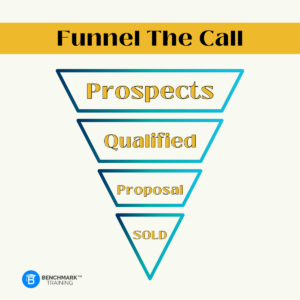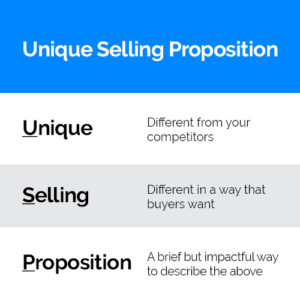Cold Calling
verb | cold call•ing
The solicitation of a potential customer who had no prior interaction with a sales person.
Prospecting is critical to the survival of any business, and when it comes to making cold calls, you have to be prepared for success.
Most salespeople would admit that cold calling is not their favorite task, whether it is because cold calling is discouraging, tedious, or even frightening.
Unfortunately, an individual’s struggle with cold calling can affect their quotas, debilitate their confidence in their skills, and even cause them to leave their sales career altogether.

What makes a successful cold calling sales professional?
Persistence, creativity, and the willingness to endure repeated rejection are key.
At Benchmark Training, we understand the pains of cold calling and we have worked with thousands of clients to create a step by step process to ease the troubles of cold calling.
Download our Cold Calling Worksheet here:
Step 1: Provide Relevant Value
When your prospect answers the phone, you have 15 seconds to get their attention.
You can do that by being relevant to the needs of your prospect.
In some cases, being relevant could mean showing them your unique selling proposition (USP) and that you can provide value to them, their team, or to their company, and doing so in a way that clicks with that individual. In other cases, simply showing them that you are a real human on the other line and that you respect their time, as well as your own will help you buy those crucial first 15 seconds.
In highly consultative sales processes, you will want to research your prospects before your call. That way you know your prospect and have more information to build rapport and trust. In more transactional sales roles, you won’t have much time for research as your calling strategy may be more about quantity than quality.
Either way, when you build good rapport and trust with your prospect, it will be easier to connect with their immediate needs.

Step 2: Engage the Prospect
Once you are able to show relevant value to your prospect, immediately ask your prospect a question that requires thought around the problem that your solution solves.
Your goal in Step 2 is to disrupt their normal thinking patterns so they want to engage.
This disruption allows your prospect to reflect on their problem and if done correctly, see the value of your solution. After prospect answers, continue the dialogue with 1-2 questions. The additional information you receive will help you pre-qualify your prospect.
Step 3: Funnel the call toward the desire to close
Now that you have engaged your client, you need to continue to funnel the call toward the desired to close or advance.
Once you have prequalified the prospect, you will want to guide the conversation toward the desire to close with a directing statement.
A directing statement provides the logic behind the question you are about to ask.
For example:
“It seems like we may be able to help increase your software adoption rate; let’s schedule a quick call with one of our adoption specialists to see if there is a fit.
[Continue to funnel the call towards a specific date and time]
When is your schedule less busy? In the beginning of the week or maybe towards the end of the week?”
To make the most of the information you just read, take a few minutes to write a script for each of the three steps. Be relevant, engage your prospect, and funnel the call to your desired action.
Once you’ve written your first draft, you will want to practice with a colleague and/or on video so that you can adjust your script as necessary. You will want your script to sound natural and engaging.
When you are making these cold calls, pay attention to what is working and find opportunities where you can improve. Continue to revise and improve your cold calling formula so you can see the best results.
From executive leadership development, to frontline team members, when everyone communicates effectively, both internally and externally, companies create a competitive advantage that is difficult for their competitors to imitate.
How Can Benchmark Training Help Your Team Succeed?
Benchmark Training helps companies build a culture of profitability through people development.
From executive leadership development, to frontline team members, when everyone communicates effectively, both internally and externally, companies create a competitive advantage that is difficult for their competitors to imitate.
Use this information and our cold calling worksheet to feel confident and prepared for your next round of calls.

"The Benchmark team was able to increase productivity and engagement for all parties."
"No matter what level your sales or coaching skills are at currently, [Benchmark] will help you improve and break through to the next level. If you are new, he will help to increase your confidence and skills. If you are experienced, he will make you a pro."

"...Benchmark Training [has] changed my life and the trajectory of my professional career."
"...has helped me rearchitect my sales process ...I continue to make progress each week and have not hit a plateau yet (we've been working together for nine months)."

"...hands down, this one stood out to our team as one of the best!"
"It left our team feeling motivated and ready to put his advice to work. [the] presentation really covers the vital nuances of what it takes to build meaningful relationships and the importance of active listening to help us excel in our fundraising efforts."

"We are winning more business than before..."
"...can honestly say I've never had so much dynamic insight and incredibly useful guidance, support and advice from any Sales Coach before. Ben is an absolute genius..."

“...Engaging, informative, and inspiring”
"I would highly recommend Benchmark for any sales coaching and/or training for your sales teams."

“...the sharpest sales mind I’ve ever encountered."
"I’ve gained more knowledge and instinct under his coaching than I ever could have expected or asked for. Whether you’re a VP of Sales or a brand new rep, talk to the professor."

“...has really helped myself and the team remain with the client at the forefront of our minds..."
"Benchmark has been brilliant at explaining ways in which to be deliberate and conscious in our thought processes, so that we can be proactive and deliver great results for our customers."

“Sales Visionary is the phrase that comes to mind when I think of Benchmark.”
"I have had the pleasure of being coached by Benchmark for the past few months and the experience and knowledge it has provided me with is invaluable."

"There aren't enough words to describe how essential Justin and Benchmark have become in my career and life."
"Justin and Ben have developed a full-proof strategy and learning platform that I would stand on the rooftops and scream to any person who wants to take a sales career they are proud of and use it become a true superstar in this industry."




